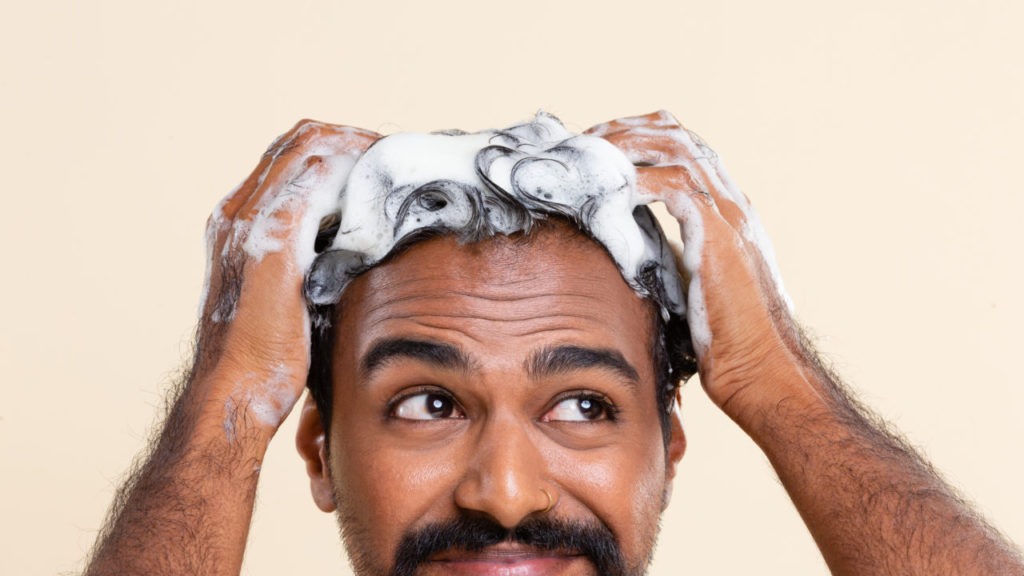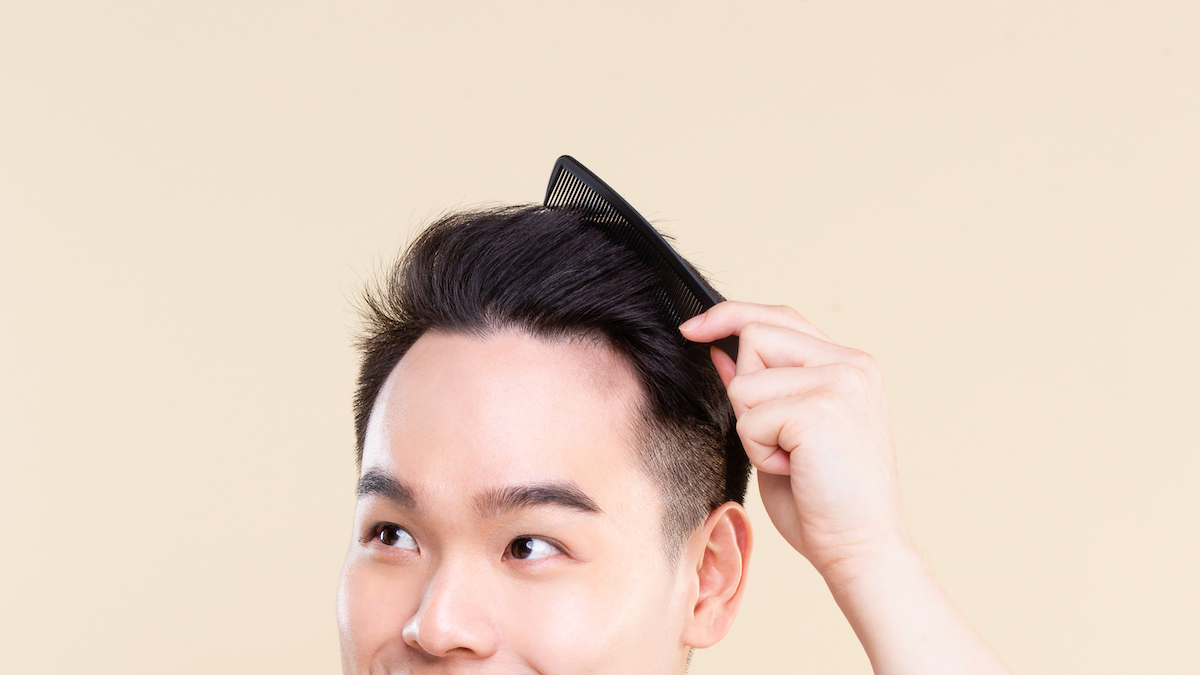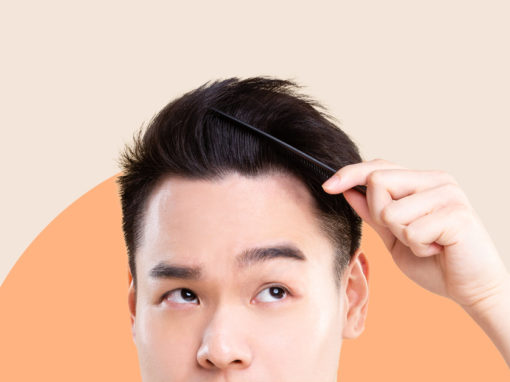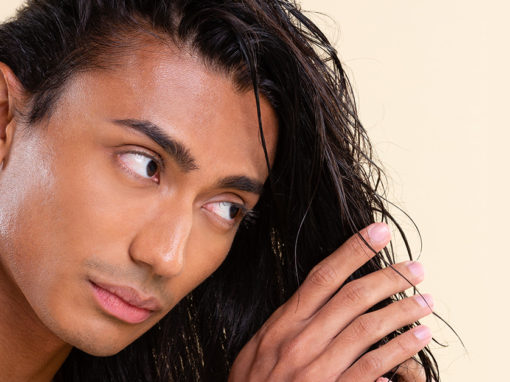Androgenetic alopecia or male pattern baldness affects over 50% of men above 50. It’s caused by genetics and characterised by receding hairlines and thinning hair at the top of the head. This will eventually lead to partial or complete baldness. Autoimmune conditions and stress can also cause hair loss.
Fortunately, some hair loss treatments can slow and even stop the process.
However, it would help if you choose the appropriate treatment according to what’s causing the hair loss. For example, for hair loss caused by stress, it’s much better to find ways to reduce stress than to take medication for it.
We’ve put together information on hair loss treatments available in Malaysia to enable you to make an informed decision before buying a supplement or hair serum that might or might not work.

What is male pattern hair loss?
Hair loss in men occurs when hair falls out quicker than usual and is not replaced by the growth of new hair. Although it’s common for people to lose up to 100 hairs a day, new hair growth replaces lost hair. However, this does not happen for men experiencing hair loss or male pattern baldness. As a result, hair becomes thinner, and a bald patch may appear.
Read: Hair loss in men – what you need to know
Symptoms of hair loss
Hair loss can occur in numerous ways, affecting more than just your scalp. Its onset can be sudden or gradual, depending on the cause.
Some signs of hair loss are:
- Thinning hair on top of the head
This is common and occurs gradually as you age. For men, you’ll notice a receding hairline on the forehead. - Bald spots that are circular and/or patchy
Bald patchy sports that are circular may appear on the eyebrows, beard or scalp. - Excessive hair fall
This is usually temporary but causes thinner hair. Handfuls of hair coming off can be due to an emotional or physical shock. - Full body hair loss
Some treatments, such as chemotherapy, can cause hair loss in all areas of your body. - Scaly patches on the scalp accompanied by redness, swelling, and broken hair
This hair loss is likely caused by ringworm.
Causes of hair loss in men
Hair loss in men can be due to:
- Genetics
Male pattern baldness (androgenic alopecia) is genetic. If your male relatives have it, you have an increased chance of developing it. Male pattern baldness may start with a receding hairline, or thinning hair on top of the head. - Medication
Some medications, like those for cancer, cause hair loss. However, your hair will likely grow back once you’re off the drug. - Medical conditions
Hormonal issues and autoimmune diseases can lead to hair loss. For example, people with alopecia areata, an autoimmune condition, have bald patches because the disease attacks hair follicles. Trichotillomania, a hair-pulling disorder, is another condition that results in hair loss. - Stress
Stressful events or long-term, chronic stress can cause hair loss.
Types of hair loss treatments in Malaysia
For most men, hair loss is due to male pattern baldness. There are several ways to slow, stop and manage hair loss in men.

Medication
Hereditary baldness can be treated with medication such as:
Minoxidil (Rogaine)
Minoxidil was initially developed as a medication for high blood pressure. However, it had a side effect – unwanted hair growth. Seemingly, minoxidil widens hair follicles and prolongs the hair growth period. This means thicker, longer and more hair. As such, it was considered as a treatment for male pattern baldness.
Minoxidil is safe, effective and available in liquid, foam, shampoo and serum forms. It’s applied once or twice daily on the scalp for men. However, you’ll need to use it consistently for a few months before seeing the results.
There are also possible side effects, such as skin/scalp irritation, allergic contact dermatitis and unwanted hair growth on the face and hands.
Finasteride (Propecia)
Finasteride is a prescription drug taken orally that was initially developed for prostate cancer treatment. However, this drug decreases dihydrotestosterone (DHT) levels in the scalp. DHT is a hormone that seems to cause hair follicles to be thinner; thus, reducing this hormone is a means to slow hair loss and promote new hair growth.
If you’re on finasteride, you’ll have to wait a few months before seeing its effect. Several side effects such as erectile dysfunction, decreased sex drive and depression are possible, but this is rare.
Hair transplants
Hair transplant, also known as restoration surgery, is an excellent treatment for those who are balding at the top of the head. Hair will be transplanted to the bald spot from other parts of your head that still have hair.
Your doctor may perform follicular unit transplantation (FUT) where a strip of skin with lots of hair is removed. Follicles from the skin are then removed and transplanted to the bald scalp areas.
Alternatively, you can opt for follicular unit extraction (FUE), where hair follicles are removed from the scalp directly. They are then transplanted to bald areas.
A hair transplant can be painful, and thus, you’ll be sedated for the procedure. There are also risks such as bruising, bleeding, swelling and infections. Additionally, you may have to undergo the process a few times before achieving the desired results.
A significant disadvantage of hair transplants is that hereditary hair loss will still progress sooner or later. As such, some people feel that it is not worth the pain, risks and costs.
Laser treatment
Laser treatment may help reduce follicle inflammation and improve hair density. Therefore, it is a suitable treatment for hair loss due to conditions such as alopecia areata. In addition, research on low-level laser therapy (LLLT) has also shown that it is effective for male pattern hair loss.
Lifestyle changes
Certain lifestyle habits may also have an impact on hair health. As such, making some lifestyle changes may help slow hair loss.

Eat right
A healthy, balanced diet may help keep hair healthy. A review found that the following vitamins and minerals may help manage hair loss:
- Foods rich in iron (green leafy vegetables, lean red meat, beans, eggs, iron-fortified cereals and grains)
- Foods high in protein (lean meat, eggs)
- Foods rich in omega-3 fatty acids (salmon, tuna, mackerel, eggs, flax seeds, hemp seeds, and nuts).
It’s best to limit sugary foods and ensure that you’re drinking an adequate amount of water every day.
Stop smoking
Smoking has numerous adverse effects, and it seems like hair loss can now be added to the list. Research among 1,000 men discovered that smokers were more likely to experience hair loss than men who didn’t smoke. Thus, stopping cigarettes may help slow hair loss.
Reduce stress
Stress affects your health in many ways, including causing hair loss. Hence, reducing stress could help stop you from going bald. Try the following to reduce stress:
- Exercise regularly
- Meditate
- Get adequate rest/sleep
- Listen to music
- Do something you enjoy
Scalp massages
If you haven’t started scalp massages, you might want to as it helps stimulate hair follicles. A study that evaluated hair thickness, total hair number, and hair growth rate found then men who had 4-minute scalp massages every day for 24 weeks had thicker hair at the end of the period. Additionally, massages help release stress, so you’ll feel amazing after.
Wigs and hairpieces
Wigs and hairpieces offer a nonmedical approach to hair loss. They’re perfect for permanent hair loss and if the baldness is caused by medication or a medical condition. For example, many cancer patients undergoing chemotherapy opt for wigs and hairpieces.
Hair care
One ‘treatment’ you can start immediately for hair loss is to be gentle with your hair. You might want to avoid the following when styling your hair:
- Tight hairstyles that pull your hair, including cornrows, bus, braids and pigtails
- Hair styling irons that use heat for styling your hair
- Hair straightening treatments and perms that use chemicals
- Bleaching your hair
Ultimately, be gentle when you’re combing or brushing your hair.
Alternative hair loss remedies
Oils
Some people believe that certain oils can help increase blood circulation to the scalp and/or improve hair regrowth. These includes:
- Rosemary oil
- Coconut oil
- Peppermint oil
- Castor oil
- Olive oil
However, research on these oils is limited and more is needed before any conclusion can be made.
Biotin
Biotin or Vitamin B7 is found in foods such as milk, eggs, sweet potatoes, bananas, nuts, oats and onions. Biotin deficiency symptoms include a scaly rash around the nose, mouth and eyes and thinning hair.
Biotin supplementation helps reduce the deficiency and, as such, may help with hair loss. However, there’s insufficient evidence to support this. If you’re on biotin supplements, let your doctors know as it may interfere with blood tests.

Prices for hair loss treatment in Malaysia
Depending on the type of treatment you undergo, you can expect hair thickening shampoos and conditioners to cost RM40 and above per bottle.
andSons offers affordable hair loss treatment plan options at RM99 per month, including:
- Hair loss prescription kit with MOH-approved Finasteride and Minoxidil 5%, and a
- Hair loss non-prescription kit with thickening shampoo, conditioner and Minoxidil 5%.
Hair loss treatment in Malaysia: FAQ
Do hair loss treatments work?
Yes, hair loss treatments do work. You can slow or stop male pattern baldness and even grow back some hair.
Which lack of vitamin causes hair fall?
Vitamin D deficiency can cause hair loss and stunted hair growth. This is because Vitamin D plays a role in the stimulation of both old and new hair follicles.
How can I regrow lost hair?
You can regrow lost hair with the treatment options mentioned above. This includes medication, hair transplants, lifestyle changes and taking proper care of your hair. You can also try alternative hair loss remedies.
Do dermatologists treat hair loss?
Yes, dermatologists can diagnose and treat hair loss. They can prescribe you medication such as minoxidil and finasteride to slow and stop baldness. They can also offer you practical hair care tips.
What happens when you stop minoxidil?
It’s likely that hair loss will eventually occur if you’re taking minoxidil for male pattern baldness.
Can hair grow back after balding?
This depends on the cause of hair loss. For example, male pattern baldness is usually permanent. Doctors can only help slow and prevent further thinning with medication and other treatments. However, if hair loss is due to medication such as chemotherapy, it’s hair will likely regrow when treatment ends.
What foods help hair grow thicker?
There isn’t any food that will guarantee thicker hair. However, a balanced, healthy diet does help produce healthy hair. Opt for food rich in iron, protein and omega-3 fatty acids.
What foods cause hair loss?
Some foods that might contribute to hair loss include:
- Sugar
- Refined carbohydrates
- Greasy food
- Carbonated drinks
- Alcohol
Conclusion
Although hair loss can’t be prevented if it’s due to genetics, it can be slowed and managed with the appropriate hair treatments.
This article is for informational purposes only and does not constitute medical advice. The information contained herein is not a substitute for and should never be relied upon for professional medical advice.
Book a consultation with andSons Malaysia’s medical team to learn about available hair loss treatment plans.


